Xing Zhao
Ring Artifacts Correction Based on Global-Local Features Interaction Guidance in the Projection Domain
Apr 15, 2025Abstract:Ring artifacts are common artifacts in CT imaging, typically caused by inconsistent responses of detector units to X-rays, resulting in stripe artifacts in the projection data. Under circular scanning mode, such artifacts manifest as concentric rings radiating from the center of rotation, severely degrading image quality. In the Radon transform domain, even if the object's density function is piecewise discontinuous in certain regions, the projection images remain nearly continuous in the angular direction, making the ideal projections exhibit a smooth global low-frequency characteristic. In practical scanning, the local disturbances of the same detector unit at different scanning angles lead to a prominent high-frequency locality of stripe artifacts. Existing studies generally model ring artifacts disturbances as fixed additive errors, which overlooks the dynamic variation of detector responses during practical scanning. However, the degree of detector response inconsistency is a function of the projection values, as revealed in our experiments, thereby requiring consideration of the interaction between global and local features in the process of stripe artifacts extraction and correction. Therefore, we propose a CT ring artifacts correction method based on global and local features in the projection domain. We employ the VSS block and Dense block to respectively correct the low-frequency sub-band, which capture the global correlations of the projection, and the high-frequency sub-band, which contain local stripe artifacts after wavelet decomposition. Specifically, the accuracy of artifacts correction is enhanced by the interaction guidance between global and local features. Extensive experiments demonstrate that our method achieves superior performance in both quantitative metrics and visual quality, verifying its robustness and practical applicability.
A Comprehensive Scatter Correction Model for Micro-Focus Dual-Source Imaging Systems: Combining Ambient, Cross, and Forward Scatter
Mar 18, 2025Abstract:Compared to single-source imaging systems, dual-source imaging systems equipped with two cross-distributed scanning beams significantly enhance temporal resolution and capture more comprehensive object scanning information. Nevertheless, the interaction between the two scanning beams introduces more complex scatter signals into the acquired projection data. Existing methods typically model these scatter signals as the sum of cross-scatter and forward scatter, with cross-scatter estimation limited to single-scatter along primary paths. Through experimental measurements on our selfdeveloped micro-focus dual-source imaging system, we observed that the peak ratio of hardware-induced ambient scatter to single-source projection intensity can even exceed 60%, a factor often overlooked in conventional models. To address this limitation, we propose a more comprehensive model that decomposes the total scatter signals into three distinct components: ambient scatter, cross-scatter, and forward scatter. Furthermore, we introduce a cross-scatter kernel superposition (xSKS) module to enhance the accuracy of cross-scatter estimation by modeling both single and multiple crossscatter events along non-primary paths. Additionally, we employ a fast object-adaptive scatter kernel superposition (FOSKS) module for efficient forward scatter estimation. In Monte Carlo (MC) simulation experiments performed on a custom-designed waterbone phantom, our model demonstrated remarkable superiority, achieving a scatter-toprimary-weighted mean absolute percentage error (SPMAPE) of 1.32%, significantly lower than the 12.99% attained by the state-of-the-art method. Physical experiments further validate the superior performance of our model in correcting scatter artifacts.
First performance of hybrid spectra CT reconstruction: a general Spectrum-Model-Aided Reconstruction Technique (SMART)
Oct 24, 2024Abstract:Hybrid spectral CT integrates energy integrating detectors (EID) and photon counting detectors (PCD) into a single system, combining the large field-of-view advantage of EID with the high energy and spatial resolution of PCD. This represents a new research direction in spectral CT imaging. However, the different imaging principles and inconsistent geometric paths of the two detectors make it difficult to reconstruct images using data from hybrid detectors. In addition, the quality reconstructed images considering spectrum is affected by the accuracy of spectral estimation and the scattered photons. In this work, Firstly, we propose a general hybrid spectral reconstruction method that takes into account both the spectral CT imaging principles of the two different detectors and the influence of scattered photons in the forward process modelling. Furthermore, we also apply volume fraction constraints to the results reconstructed from the two detector data. By alternately solving the spectral estimation and the spectral image reconstruction by the ADMM method, the estimated spectra and the reconstructed images reinforce each other, thus improving the accuracy of the spectral estimation and the quality of the reconstructed images. The proposed method is the first to achieve hybrid spectral CT reconstruction for both detectors, allowing simultaneous recovery of spectrum and image reconstruction from hybrid spectral data containing scattering. In addition, the method is also applicable to spectral CT imaging using a single type of detector. We validated the effectiveness of the proposed method through numerical experiments and successfully performed the first hybrid spectral CT reconstruction experiment on our self-developed hybrid spectral CT system.
Iterative approach to reconstructing neural disparity fields from light-field data
Jul 22, 2024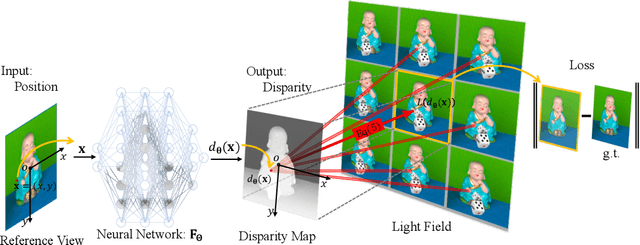
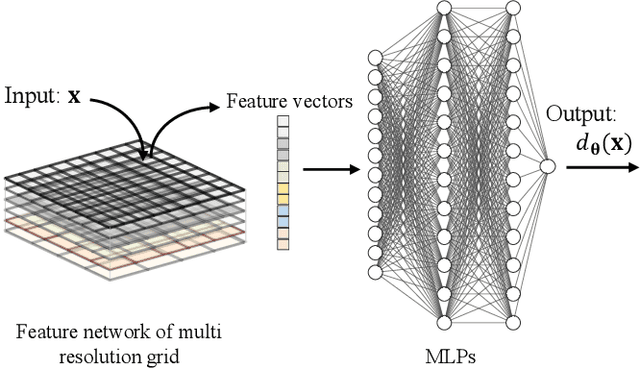
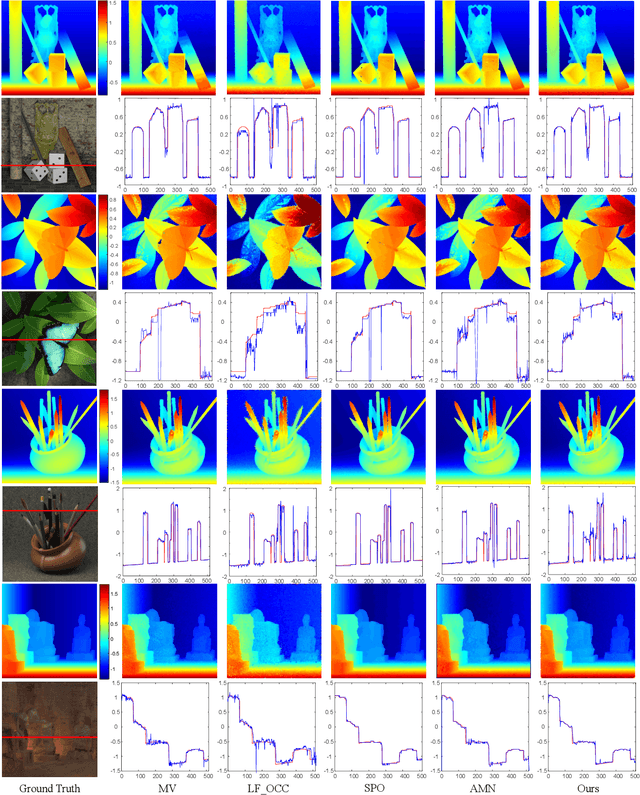
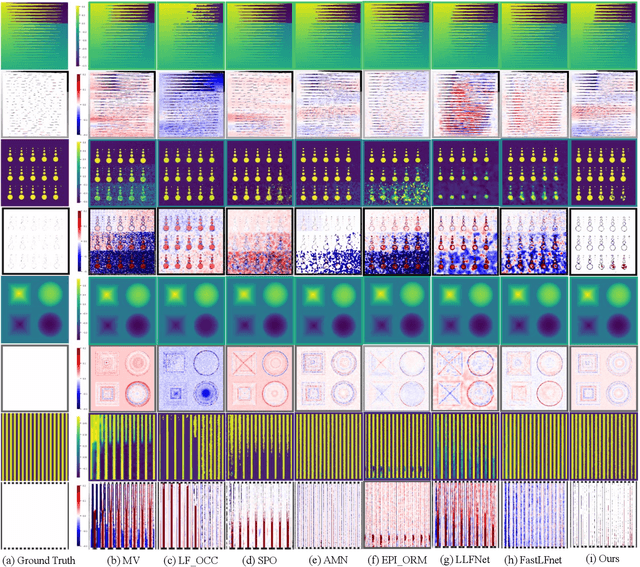
Abstract:This study proposes a neural disparity field (NDF) that establishes an implicit, continuous representation of scene disparity based on a neural field and an iterative approach to address the inverse problem of NDF reconstruction from light-field data. NDF enables seamless and precise characterization of disparity variations in three-dimensional scenes and can discretize disparity at any arbitrary resolution, overcoming the limitations of traditional disparity maps that are prone to sampling errors and interpolation inaccuracies. The proposed NDF network architecture utilizes hash encoding combined with multilayer perceptrons to capture detailed disparities in texture levels, thereby enhancing its ability to represent the geometric information of complex scenes. By leveraging the spatial-angular consistency inherent in light-field data, a differentiable forward model to generate a central view image from the light-field data is developed. Based on the forward model, an optimization scheme for the inverse problem of NDF reconstruction using differentiable propagation operators is established. Furthermore, an iterative solution method is adopted to reconstruct the NDF in the optimization scheme, which does not require training datasets and applies to light-field data captured by various acquisition methods. Experimental results demonstrate that high-quality NDF can be reconstructed from light-field data using the proposed method. High-resolution disparity can be effectively recovered by NDF, demonstrating its capability for the implicit, continuous representation of scene disparities.
Ray-driven Spectral CT Reconstruction Based on Neural Base-Material Fields
Apr 10, 2024Abstract:In spectral CT reconstruction, the basis materials decomposition involves solving a large-scale nonlinear system of integral equations, which is highly ill-posed mathematically. This paper proposes a model that parameterizes the attenuation coefficients of the object using a neural field representation, thereby avoiding the complex calculations of pixel-driven projection coefficient matrices during the discretization process of line integrals. It introduces a lightweight discretization method for line integrals based on a ray-driven neural field, enhancing the accuracy of the integral approximation during the discretization process. The basis materials are represented as continuous vector-valued implicit functions to establish a neural field parameterization model for the basis materials. The auto-differentiation framework of deep learning is then used to solve the implicit continuous function of the neural base-material fields. This method is not limited by the spatial resolution of reconstructed images, and the network has compact and regular properties. Experimental validation shows that our method performs exceptionally well in addressing the spectral CT reconstruction. Additionally, it fulfils the requirements for the generation of high-resolution reconstruction images.
Practitioners' Challenges and Perceptions of CI Build Failure Predictions at Atlassian
Feb 15, 2024



Abstract:Continuous Integration (CI) build failures could significantly impact the software development process and teams, such as delaying the release of new features and reducing developers' productivity. In this work, we report on an empirical study that investigates CI build failures throughout product development at Atlassian. Our quantitative analysis found that the repository dimension is the key factor influencing CI build failures. In addition, our qualitative survey revealed that Atlassian developers perceive CI build failures as challenging issues in practice. Furthermore, we found that the CI build prediction can not only provide proactive insight into CI build failures but also facilitate the team's decision-making. Our study sheds light on the challenges and expectations involved in integrating CI build prediction tools into the Bitbucket environment, providing valuable insights for enhancing CI processes.
Lab-in-a-Tube: A portable imaging spectrophotometer for cost-effective, high-throughput, and label-free analysis of centrifugation processes
Aug 01, 2023



Abstract:Centrifuges serve as essential instruments in modern experimental sciences, facilitating a wide range of routine sample processing tasks that necessitate material sedimentation. However, the study for real time observation of the dynamical process during centrifugation has remained elusive. In this study, we developed an innovative Lab_in_a_Tube imaging spectrophotometer that incorporates capabilities of real time image analysis and programmable interruption. This portable LIAT device costs less than 30 US dollars. Based on our knowledge, it is the first Wi Fi camera built_in in common lab centrifuges with active closed_loop control. We tested our LIAT imaging spectrophotometer with solute solvent interaction investigation obtained from lab centrifuges with quantitative data plotting in a real time manner. Single re circulating flow was real time observed, forming the ring shaped pattern during centrifugation. To the best of our knowledge, this is the very first observation of similar phenomena. We developed theoretical simulations for the single particle in a rotating reference frame, which correlated well with experimental results. We also demonstrated the first demonstration to visualize the blood sedimentation process in clinical lab centrifuges. This remarkable cost effectiveness opens up exciting opportunities for centrifugation microbiology research and paves the way for the creation of a network of computational imaging spectrometers at an affordable price for large scale and continuous monitoring of centrifugal processes in general.
Matching entropy based disparity estimation from light field
Oct 28, 2022Abstract:A major challenge for matching-based depth estimation is to prevent mismatches in occlusion and smooth regions. An effective matching window satisfying three characteristics: texture richness, disparity consistency and anti-occlusion should be able to prevent mismatches to some extent. According to these characteristics, we propose matching entropy in the spatial domain of light field to measure the amount of correct information in a matching window, which provides the criterion for matching window selection. Based on matching entropy regularization, we establish an optimization model for depth estimation with a matching cost fidelity term. To find the optimum, we propose a two-step adaptive matching algorithm. First, the region type is adaptively determined to identify occluding, occluded, smooth and textured regions. Then, the matching entropy criterion is used to adaptively select the size and shape of matching windows, as well as the visible viewpoints. The two-step process can reduce mismatches and redundant calculations by selecting effective matching windows. The experimental results on synthetic and real data show that the proposed method can effectively improve the accuracy of depth estimation in occlusion and smooth regions and has strong robustness for different noise levels. Therefore, high-precision depth estimation from 4D light field data is achieved.
Motion-aware Memory Network for Fast Video Salient Object Detection
Aug 01, 2022
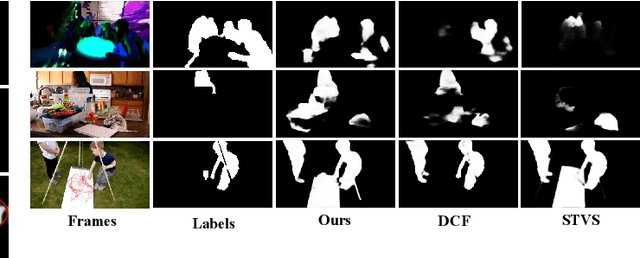
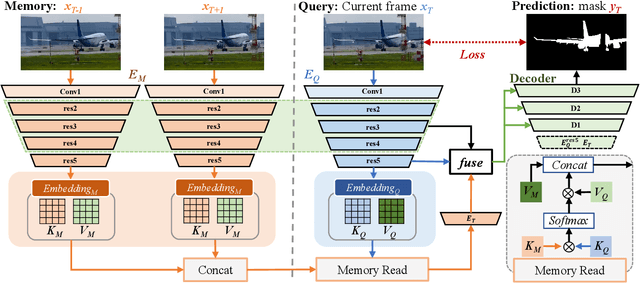

Abstract:Previous methods based on 3DCNN, convLSTM, or optical flow have achieved great success in video salient object detection (VSOD). However, they still suffer from high computational costs or poor quality of the generated saliency maps. To solve these problems, we design a space-time memory (STM)-based network, which extracts useful temporal information of the current frame from adjacent frames as the temporal branch of VSOD. Furthermore, previous methods only considered single-frame prediction without temporal association. As a result, the model may not focus on the temporal information sufficiently. Thus, we initially introduce object motion prediction between inter-frame into VSOD. Our model follows standard encoder--decoder architecture. In the encoding stage, we generate high-level temporal features by using high-level features from the current and its adjacent frames. This approach is more efficient than the optical flow-based methods. In the decoding stage, we propose an effective fusion strategy for spatial and temporal branches. The semantic information of the high-level features is used to fuse the object details in the low-level features, and then the spatiotemporal features are obtained step by step to reconstruct the saliency maps. Moreover, inspired by the boundary supervision commonly used in image salient object detection (ISOD), we design a motion-aware loss for predicting object boundary motion and simultaneously perform multitask learning for VSOD and object motion prediction, which can further facilitate the model to extract spatiotemporal features accurately and maintain the object integrity. Extensive experiments on several datasets demonstrated the effectiveness of our method and can achieve state-of-the-art metrics on some datasets. The proposed model does not require optical flow or other preprocessing, and can reach a speed of nearly 100 FPS during inference.
Human-centric Image Cropping with Partition-aware and Content-preserving Features
Jul 21, 2022


Abstract:Image cropping aims to find visually appealing crops in an image, which is an important yet challenging task. In this paper, we consider a specific and practical application: human-centric image cropping, which focuses on the depiction of a person. To this end, we propose a human-centric image cropping method with two novel feature designs for the candidate crop: partition-aware feature and content-preserving feature. For partition-aware feature, we divide the whole image into nine partitions based on the human bounding box and treat different partitions in a candidate crop differently conditioned on the human information. For content-preserving feature, we predict a heatmap indicating the important content to be included in a good crop, and extract the geometric relation between the heatmap and a candidate crop. Extensive experiments demonstrate that our method can perform favorably against state-of-the-art image cropping methods on human-centric image cropping task. Code is available at https://github.com/bcmi/Human-Centric-Image-Cropping.
 Add to Chrome
Add to Chrome Add to Firefox
Add to Firefox Add to Edge
Add to Edge